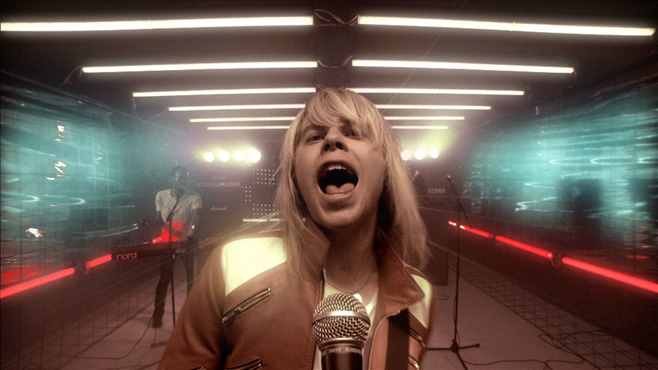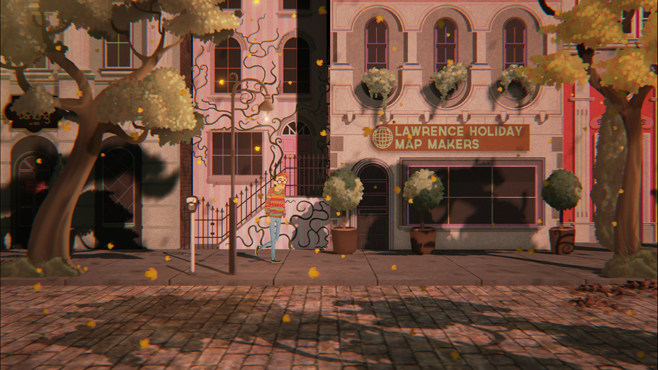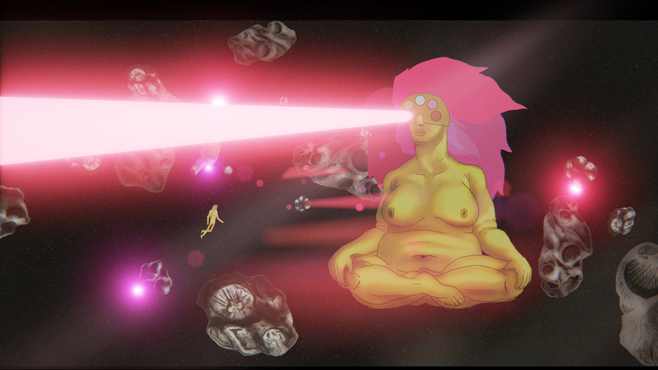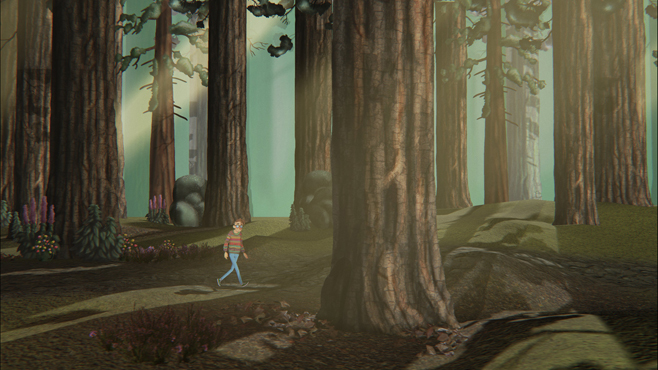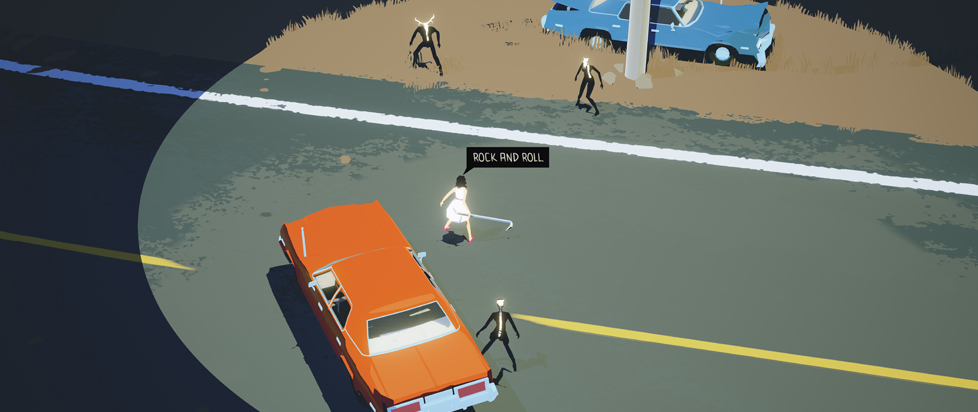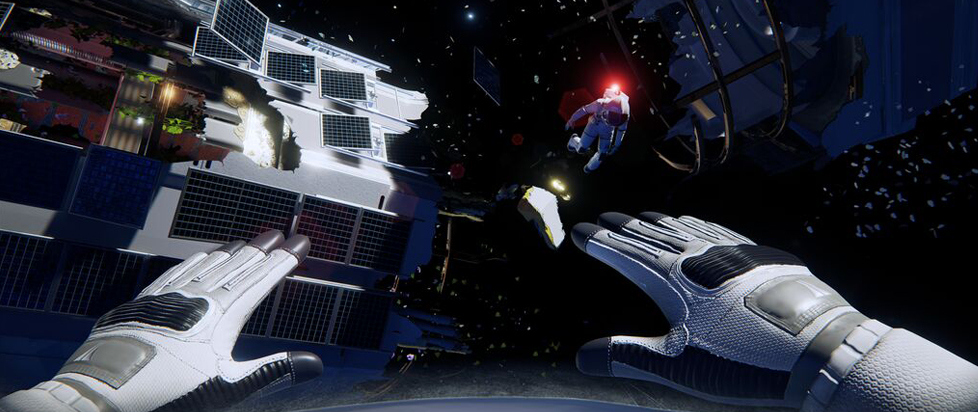
Revving the Engine: The Artful Escape of Francis Vendetti
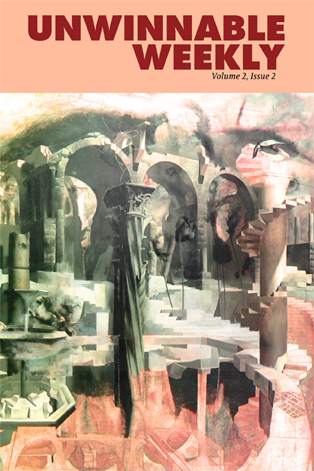 The following is a reprint from Unwinnable Weekly Issue Fifty Four. If you enjoy what you read, please consider purchasing the issue or subscribing.
The following is a reprint from Unwinnable Weekly Issue Fifty Four. If you enjoy what you read, please consider purchasing the issue or subscribing.
This series of articles is made possible through the generous sponsorship of Epic’s Unreal Engine. While Epic puts us in touch with our subjects, they have no input or approval in the final story.
———
Have you ever wanted to be someone else?
Sure you have. We all have.
Anyone who has ever performed on stage will tell you that they are a different person in front of the audience. The mundane version of yourself melts away and a fiction, created as a kind of collaboration between the performer and the spectators, steps forth.
It’s a kind of magic. That’s the central idea of The Artful Escape of Francis Vendetti, the forthcoming game from Beethoven & Dinosaur. And it is something Johnny Galvatron, the lead designer, knows a thing or two about.
Growing up in Australian rules football-obsessed Geelong, Australia, on a steady diet of David Bowie, Talking Heads, Van Halen, Prince and Devo, it was probably only a matter of time before Johnny formed a band. He got his first bass when he was 13. His first band followed soon after.
Three or four bands later, he was fronting The Galvatrons on a world tour. A few years after that, he was writing a novel in seclusion. Now he’s working on a videogame.
Johnny was kind enough to take some time out of his schedule to chat with me about The Artful Escape of Francis Vendetti and the ever-shifting personas of creative people.
How did things go with The Galvatrons?
I was at university studying computer animation. A week after I graduated, after the Galvatrons’ fourth show, we signed to Warner Brothers and the next four years are a bit of a blur. We toured the world, played stadiums, played huge festivals, had a couple of hits, went on TV gameshows, played on TV, played laser tag with bikini models (really), toured with Def Leppard, played festivals with Kiss and The Police, got chased by paparazzi with Justin Hawkins in London, set off the fire alarms at strip club on Halloween and filled the street with almost naked vampires. Got arrested a couple of times. The band broke up, as bands do, and I moved away from music. I wasn’t cut out for touring and I spent the next couple of years writing a novel, hardly leaving the house.
Was there anything in particular about touring that got you off the road?
It’s hard to pin down why touring is so difficult. Obviously you miss family and friends, you’re plastered every frickin’ day, there are big highs and big lows. There’s also a saying that being in a band is just 23 hours of waiting around. That’s true. That’s what was killing me I think. Buses, planes, trucks, shitty hotel rooms, shittier hotel rooms.
How’d you make the leap from rock ‘n’ roll to game development?
I’d studied computer animation at university but never moved into the field as I’d been swept onto the road by the record deal. During and post-Galvatrons I wrote a few editorials and reviews for different online gaming sites and journals. After that, I naturally fell back into making games.
What is it about games that drew you back?
My affair with video games has similar motivations to my love of music. I read a study recently that said people who listen to heavy metal do so for the same reasons classical lovers listen to Stravinsky or Beethoven – a desire for the grandiose.
My favorite games all seem to stem from the ambient elite; Journey, Kentucky Route Zero, Gone Home. Atmosphere, I think, is paramount in games, and for those reasons I also enjoy Sword & Sworcery, the empty expanse of Shadow of the Colossus and the original Max Payne, whose drug trip levels would influence many games to come.
Do you have any work from your university days out there?
I sincerely hope not.
What is Beethoven & Dinosaur?
Beethoven & Dinosaur is a small collective of artists, musicians and programmers who have come together to work on The Artful Escape of Francis Vendetti. While everyone has years of experience and success in their fields, this will be the collective’s first project. One of the noteworthy contributes is composer Josh Abrahams. He’s worked on films with Baz Luhrmann and Ang Lee.
What is The Artful Escape of Francis Vendetti about?
The Artful Escape of Francis Vendetti is about a teenage musician who embarks on a multidimensional journey to inspire his stage persona. Francis lives in the town of Calypso, Colorado. He’s the nephew of a legendary dead folk singer and the game takes place on the eve of his debut performance. The expectations of his hometown rest heavily on Francis’s mind. The restaurants along the strip are anticipating big crowds. The venue owner promises murderous repercussions if Francis doesn’t return the bar to its glory days – when Johnson Vendetti enchanted rooms overflowing with heavy drinking patrons. And Francis’s relatives, well, they’re expecting to see their dear, lost friend reborn on stage. The problem is that, while his uncle wrote his music among the fields and rivers and sweeping acreage of Colorado, Francis writes his music among the stars.
The day before the show, Francis runs into Violetta, a Calypso alumni who works as a lighting engineer. She tells Francis of a man who can help him: Lightman, proprietor of Lightman’s Telescope and Reptile Emporium. He’s a star maker of sorts, a well of musical wisdom. His shop can only be found by breaking into an abandoned diner, playing “The High and the Mighty,” by Victor Young on the jukebox, and returning the way you came. It is these people who introduce Francis to a world lurking beneath the aging foundations of Calypso, and the inspiration for his new persona.
The visuals in the trailer are strikingly surreal. What inspired them?
I don’t want to give everything away but Francis ends up traveling a closed multidimensional roadway. I wanted this universe to have the spiraling imagination of my high school math text book, which was filled not with numbers, but little daydreams of otherworldly adventures. I wanted it to have the broad, chaotic color palette. Landscapes and creatures that defied all logic.
Does your time with The Galvatrons inform The Artful Escape? How much of Francis is autobiographical?
I think the Artful Escape of Francis Vendetti might be a version of what I thought the music industry was when I was in high school. This magic world of doors that would suddenly unlock, and the treasures beyond. Perhaps I’m trying to capture some of the liberation of pretending to be someone else entirely.
I’m surprised Francis’ uncle was a folk musician. What prompted that choice?
The Artful Escape is a magical-realist, sci-fi game, but it’s primarily about Francis growing as a performer and an artist, trying to shed the mindset of a nervous, slightly embarrassed teenage musician. I wanted Francis to be this Glam, Ziggy Stardust, Ace Frehley kind of character and, being set in Colorado, it was an obvious choice to make his uncle a John Denver, Bob Dylan kind of folk singer. Francis begins to discover that while his Uncle found his music in the everyday, his music comes from somewhere fictional and fantastical, and that’s okay too.
The first Revving the Engine interview was with Mike Blackney, developer of Dead Static Drive. He is also an Australian, also has a fascination with Kentucky Route Zero, also making a game set in some version of the United States. I’m curious why you chose the States as the setting for your game? Can you reflect on this cultural gravity the U.S. seems to have for Australians?
I think that’s a great question. I don’t think American’s can understand the mythos their country has amongst other, westernized English speaking cultures. Almost all of our pop culture comes from the States and thus, the America of the Australian’s mind (even if they don’t realize it) is a place of fantasy. It’s where most stories take place. I guess it’s a little like The Beetles singing in American accents. I also read a lot of Stephen King in my youth and a lot of his characters are based in or pass through Colorado, (especially Boulder) so, to me, it feels like there’s some magic there.
Speaking of Kentucky Route Zero – several elements of The Artful Escape seem, if not inspired by KRZ, at least poking at the same ideas (that closed magical roadway, the surreal visuals, the focus on music). Is that a fair statement?
Not intentionally, though I do love Kentucky Route Zero. I think this stems from sharing similar reference material. We may share a love of magical realism in literature. For me this means Haruki Murakami, David Mitchell and China Miéville.
Murakami has his characters delve down abandoned lane ways and wells in The Wind Up Bird Chronicles. Characters visit cabins that sit on the precipice of strange other-worlds in Kafka on the Shore. They slip into whole other realities by leaving a cab prematurely and taking flight down a highway-access stairwell in IQ84. His characters also seem to have an affinity for jazz and fringe classical music.
David Mitchell, who has been called a new-wave Murakami, has a couple of memorable musicians in his books, like Robert Frobisher in Cloud Atlas. Eiji Miyake, in my all-time favorite book, Number 9 Dream, has a small section in the novel’s first chapter where Eiji pretends to be John Lennon. Obviously it’s my own experience in music that influences The Artful Escape of Francis Vendetti, too.
Mitchell’s books are also surreal adventures, often changing style, tone, and voice several times in the same story. And Chine Miéville seems to perfectly articulate my love of secret doors, hidden worlds and cities within cities.

Why Unreal Engine? The Artful Escape (also like Dead Static Drive) isn’t a game I look at and think, “Oh, an Unreal game” you know?
The great thing about Unreal Engine is how good it looks out of the box. Create your assets, throw them in the scene, chuck on a couple of lights and you’ve already got something that’s halfway there. It just looks great. It handles sprites really well, the way they’re masked looks nice (that was a serious problem with other engines). The sprites cast and receive shadows. All that stuff is fantastic. All the features that make their 3D shooters look great are the same assets that helped us to achieve the look of The Artful Escape. The challenges stem from an engine that is still in development. There aren’t a lot of 2D assets at the moment, especially in animation, so working around those problems, or waiting for updates can be a hassle – but by and by we’re just pushing the engine in new directions. You have to be prepared to do some legwork to pull it off.
What kind of impact has the Unreal Dev Grant had on the project?
The dev grant means we can put a lot more time into gameplay and control systems before going to Kickstarter, and promoting the game on a wider level. It’s turning a good game into a great game.
The way it came about was a dream, actually. I was working on the game, and on the interface of the Unreal launch app I saw the flyer for the Unreal Dev Grants. I wrote them one email showcasing the game and what we had already done and a couple of months later I got an email saying I had been awarded with a grant. The cash was in my account a week later.
What is the plan going forward? You’ve been greenlit on Steam, you mentioned Kickstarter. Also – any (even a fuzzy) notion of when the game will surface?
We have been Greenlit on Steam! We’re very excited about that. We’ll be going to Kickstarter sometime in the next four months. The Unreal Dev Grant has allowed us to work on our pitch a lot more, which we’ll be eternally grateful for. We’re still a little over a year away for actual release.
———
To see more The Artful Escape of Francis Vendetti, visit the game’s official site.
Stu Horvath is the editor in chief of Unwinnable. He reads a lot, drinks whiskey and spends his free time calling up demons. Sometimes, he plays with toys and calls it “photography.” Follow him on Twitter @StuHorvath.
